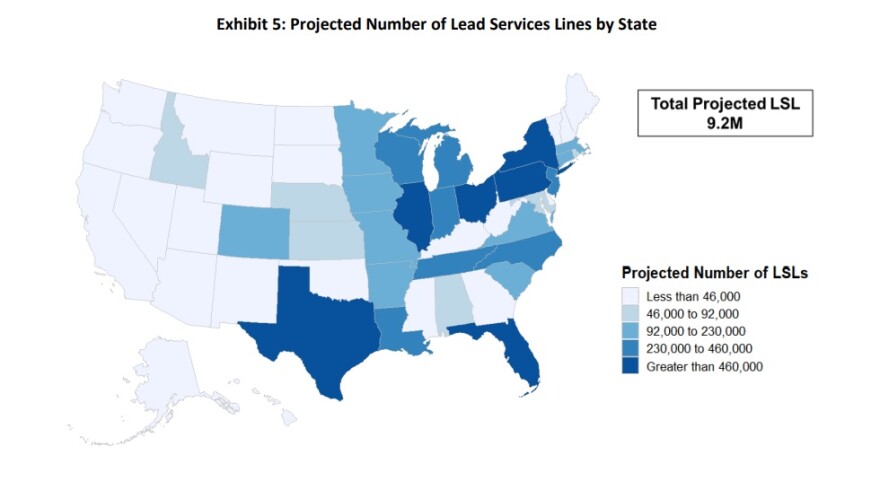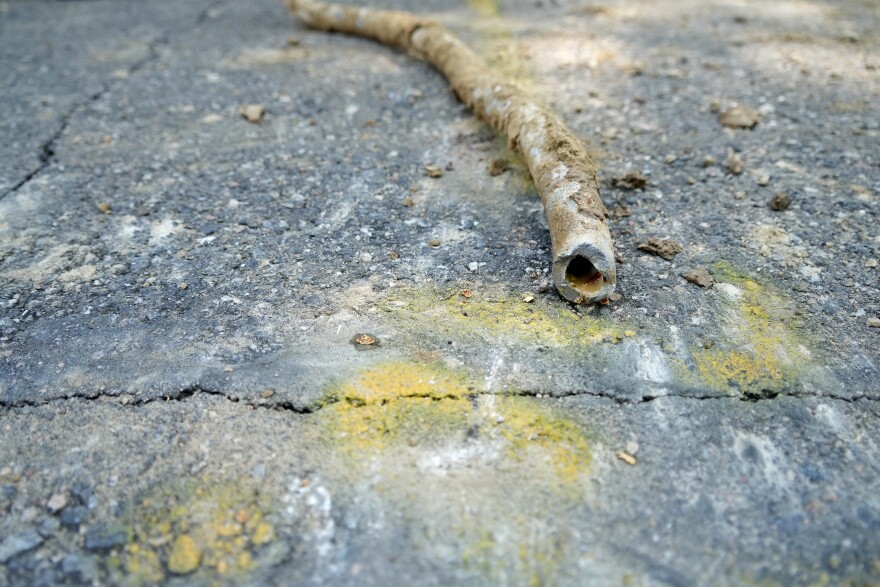WASHINGTON — Pennsylvania has a lead pipe problem.
The commonwealth ranks fourth out of all U.S. states for the most lead pipes, according to the Environmental Protection Agency’s “7th Drinking Water Infrastructure Needs Survey and Assessment,” the results of which were released Tuesday. Florida, Illinois and Ohio where the only states to rank higher.
“Water is essential. We rely on it from the moment we wake up in the morning and make a cup of coffee until we brush our teeth at night,” according to the report. “While most water infrastructure is hidden from sight, it is foundational to our daily lives.
“Our water infrastructure is aging and in need of repair to withstand the challenges of the 21st century. We must maintain and modernize our Nation’s water infrastructure to deliver clean drinking water and safely transport and treat wastewater.”
Pennsylvania has about 689,000 lead service lines, making up 7.5% of all service lines in the commonwealth, according to results of the EPA's survey. Lead poisoning and contamination, which has been found to cause permanent, disabling health effects, is an ongoing issue in the Lehigh Valley.
“Every community deserves access to safe, clean drinking water,” said EPA Administrator Michael Regan. “Thanks to President Biden’s infrastructure investments, we have an unprecedented opportunity to revitalize America’s drinking water systems, support the Biden-Harris administration’s goal of removing 100% of lead pipes across our country, and protect communities from PFAS pollution.”

Last month, the EPA announced a proposal to set nationwide maximum levels of PFAS, also known as “forever chemicals,” allowable in public drinking water. It was about three months after Pennsylvania adopted new regulations, but the EPA’s are almost four times lower.
With state and federal agencies at odds over the acceptable levels, it’s become an expensive and frustrating process for Emmaus officials, who estimate it could cost the borough upwards of $12 million if all four of its wells need to be mitigated.
The EPA on Tuesday also announced $6.5 billion will be distributed to states, U.S. territories and tribes to upgrade drinking water infrastructure, with $6 billion of that total coming from the Bipartisan Infrastructure Law.
LehighValleyNews.com has reached out to the state Department of Environmental Protection and Department of Health for comment on the EPA’s findings.
“According to [the] Department of Health, the primary source of childhood lead poisoning in Pennsylvania continues to be exposure to aging, deteriorating lead-based paint (chips and dust), and not drinking water,” according to the DEP’s website. “The age of Pennsylvania's housing stock contributes to this problem. While lead was banned from paint in 1978, many older dwellings still contain layers of pre-1978 paint.”
How lead affects health
Lead is a naturally occurring metal that has been found to cause permanent, disabling health effects, according to the Centers for Disease Control and Prevention. Exposure can happen from eating lead chips, ingesting contaminated food or water or by breathing in lead dust.
“Children younger than 6 years are more likely to be exposed to lead dust due to their hand to mouth behavior,” according to the CDC’s website. “Many children ingest lead dust by putting objects such as toys and dirt in their mouth.”
In Pennsylvania, nearly 9,000 young children suffer from lead poisoning each year, according to the Council for a Strong America, a nonprofit that focuses on children’s health outcomes.
“Children are more at risk for the damaging effects of lead than adults because children’s bodies absorb more lead and their brains and nervous systems are more susceptible to damage from lead poisoning,” according to the organization’s May 2021 report, “Preventing Childhood Lead Exposure in Pennsylvania.” “While the severity of symptoms can depend on the level of lead in a child’s blood, there is no safe level of lead exposure in children.”
Nearly 250 children in Lehigh County and 100 children in Northampton County suffer from lead poisoning each year, according to the report. Black and Hispanic children are disproportionately affected because they are more likely to live in older properties with deteriorated lead-based paint.
Last year, Lehigh University’s Muzhe Yang, a professor of economics, co-authored a study showing a causal relationship between lead in Newark’s water and adverse fetal health outcomes.
Researchers found prenatal lead exposure increased the chance of low birth weight by 18% and increased the probability of preterm birth by 19%.
“These findings have important policy implications,” said Yang in a news release from Lehigh announcing the report, “especially in light of the substantial number of lead water pipes that remain in use as part of the aging infrastructure and the cost-benefit calculus of lead abatement interventions.”
Lead in the Lehigh Valley
Lead contamination has been a known issue in the Lehigh Valley, largely because of the region’s aging housing stock.
In August, the Lehigh County Authority launched a survey to inventory all water service line pipes connected to the public system. Their goal was to determine the location of pipes composed of lead or other unknown materials.
“Your part is simple: Just check your home for lead pipes, then complete our online service line survey to tell us what you find—no matter what type of material the pipes are made of,” LCA officials said when announcing the survey.
LCA records show approximately 4,700 public lead service lines in Allentown, but an additional 9,200 service lines are of an unknown material and may be lead, authority spokesperson Susan Sampson said in an email Wednesday.
There are also about 7,700 privately-owned lines that may need to be replaced because they are lead or galvanized steel, Sampson said. An additional 7,300 privately owned service lines are made of an unknown material and may also require replacement.
Sampson said the authority is working on a lead service line database, and officials plan on developing a public-facing portal for customers to look up their own address to find out if they have a lead service line.
"We expect this tool to be developed sometime next year, as we still have a lot of work to do to verify service line material," she said.
LCA officials are also preparing a grant application to fund about $2.5 million in lead service line replacements this year, she said. The funding could replace about 150 service lines.
"If we receive grant funds, we will be selecting areas in the city to complete this work where we can help complete both the public and the private side of the service line," Sampson said. "We also hope to build some service line verification processes into the project so we can work on building out our data set on where the lead service lines exist in Allentown.
"This pilot project will help us put protocols in place to support a long-term, robust program to get the lead out of Allentown’s water system."


